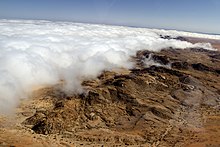Fog desert
A fog desert is a type of desert in the subtropics that is found mainly on the western coast of the continent.
Emergence
Although they have very low levels of precipitation, heavy fog is regularly formed near the coast . The Namib - around 2000 km long and 30 to 160 km wide - as a classic example of a foggy desert, is often exposed to dry spells for years and has an average rainfall of only 20 mm per year. This makes it one of the driest places on earth, even though it borders the Atlantic. Nonetheless, dense fog fields form in the early morning hours on around 200 days a year. Responsible for this fog formation are the coastal-parallel or offshore trade winds , which are warmed over the continent and create so-called upwelling areas off the coast. These winds push warm surface water away from the coast, causing cold deep currents to rise and replace the warm water.
The hot and very dry air coming from the land ( land wind ) absorbs a lot of moisture over the Atlantic. At the same time, through contact with the cold water of the Benguela Current, the air near the surface cools down and begins to condense. This cooling effect leads to the formation of fog over the sea in a strip many kilometers wide (around 250 foggy days per year). The relatively cool fog that forms over the sea is sometimes carried up to 80 km or further inland during the day with the sea wind .
The warm air above the fog prevents the cool fog below from rising, a stable inversion weather situation has formed. The fog lying on the land provides moisture, which the plants and animals of these deserts feed on (see fog condensation ). The fog overlying the land is often dissolved during the day as the temperature rises.
Examples
- Africa: Namib
- America: Atacama Desert , Baja California
See also: coastal desert
Flora and fauna
Best known are black beetles such as the white desert beetle , which stand on their heads on high dune ridges to collect condensation . The Welwitschia also benefits from the dew , thanks to its extensive roots . The desert-dwelling animals and plants in the dune valleys essentially have to get by with the fog as a moisturizer; it is their most important livelihood. In the Namib Desert, many years often pass without any measurable precipitation; uninterrupted dry periods of 10 years have already been registered. Even on the coast, rainfall is low (maximum 8 mm / year). See also dry field cultivation .


